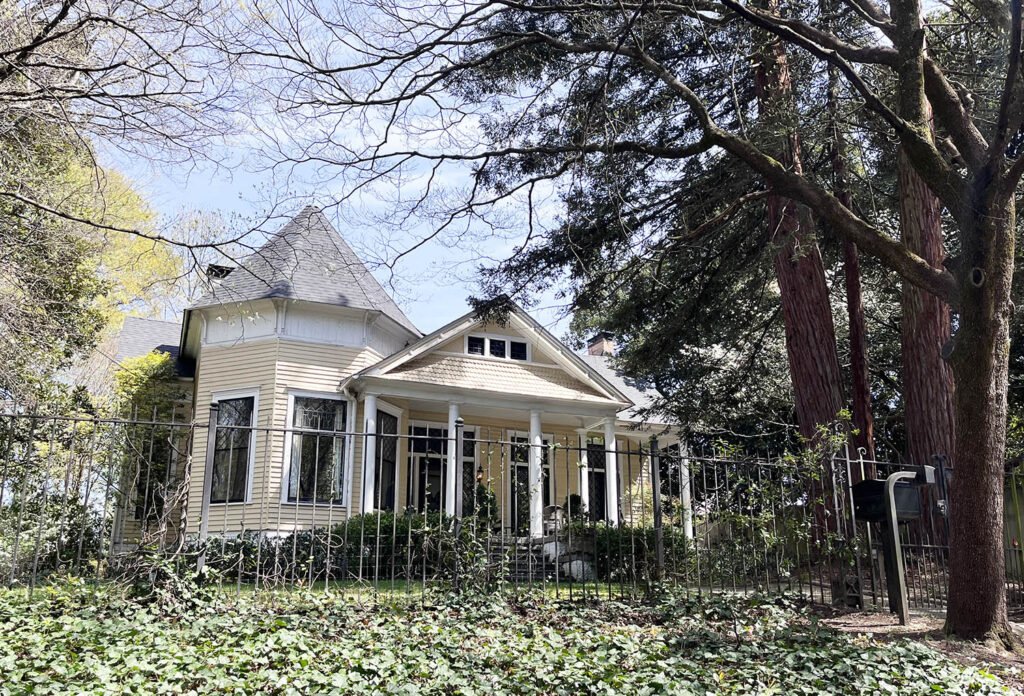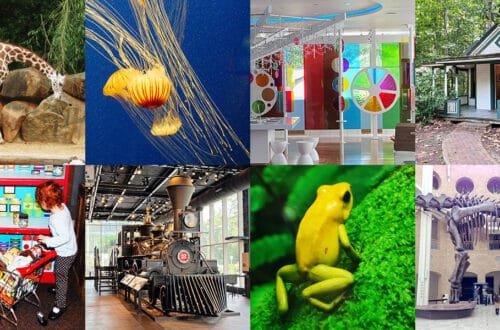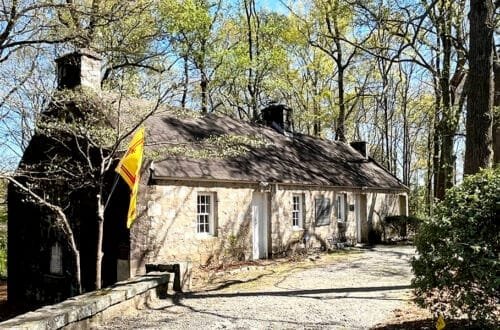
Atlanta’s Inman Park: A Neighborhood History
Inman Park is one of Atlanta’s most popular intown neighborhoods. I love to hang out in this vibrant and quirky community. It is a beautiful place to walk and there are so many excellent restaurants to enjoy. The neighborhood that we know today as Inman Park is made up of a few historic neighborhoods including the original streetcar suburb of Inman Park, Copenhill, near Highland Ave and the Carter Center, and the Atlanta Stove Works mill and its housing.
The history of the Inman Park neighborhood begins with the Battle of Atlanta, which left the land absolutely ravaged. A man named Joel Hurt had a vision for this battle scarred piece of property. Here is the story of how the Inman Park neighborhood that we know and love today came to be.
The History of Inman Park’s Land
The land where Inman Park stands today was once a farm that belonged to James Vickers Jones and his wife, Mary Elizabeth Hurt. The couple married in 1843. Jones sold portions of the land to his wife’s family, including her brothers, George Troup Hurt and Augustus Fletcher Hurt. They built homesteads on their properties. These farms were the site of the Battle of Atlanta in July 1864. Note the historic plaques placed in Delta Park and Springvale Park.
Augustus Hurt’s home, which was located on the grounds of the Carter Center, served as General Sherman’s headquarters during the battle. Historical records call it the Howard house. According to historians, Union soldiers took the house apart and used it to build shelters or as firewood. The incomplete brick house depicted in the Cyclorama’s Battle of Atlanta scene belonged to George Troup Hurt – you can visit the Cyclorama at the Atlanta History Center. The battle of Atlanta destroyed the George Troup Hurt house, located on Dekalb Ave near Degress Ave.

The Battle of Atlanta scene may refer to the Jones house as the Pope house. It is unlikely that the Jones house survived the war. The families returned to their land following the civil war and rebuilt. The Jones family built a small Italianate cottage that faced Dekalb Ave. By the 1880s, the Hurt brothers moved elsewhere. This area was known as “Edgewood” following the Civil War. Elizabeth Hurt Jones passed away in 1882 leaving her property to her sons. The Hurt-Jones plot in Oakland Cemetery is the couple’s final resting place.
The Inspiration for Atlanta’s First Suburb: Inman Park
1893 World Columbian Exposition
The 1893 World Columbian Exposition in Chicago made news across the country introducing new concepts, ideas, and products to the United States. The Chicago architect, Daniel Burnham, oversaw the design and construction of the Fairgrounds. Burnham invited world renowned architects to design the neoclassical fair buildings. All the construction was uniformly white. Frederick Law Olmsted carefully laid out the buildings in a well thought out landscape. Olmsted had recently become famous for his design of Central Park in New York in 1858.

Joel Hurt followed Frederick Law Olmsted’s work and he was familiar with the Chicago World’s Fair. The classic revival style began to spread across the country along with white paint. Compare it to today’s HGTV and social media and the recent proliferation of the modern farm house and popularity of white and grey paint. The World’s Fair had a similar effect. Atlanta was a little bit late to the fashionable Queen Anne Victorian architectural trend due to its period of Reconstruction. Victorian Grand Dames typically would have received a complicated color scheme, which earned them the name, “Painted Ladies” in many cities. However, many of the high style Queen Anne houses in Inman Park sported white paint in fashionable reference to Chicago’s “White City.”

Note: I recommend that you read the book Devil in the White City by Erik Larson for an entertaining look a the wide-reaching influence of the 1893 Chicago’s World’s Fair
The Railroad Suburb of Riverside, Illinois
Frederick Law Olmsted designed the suburb of Riverside, IL in 1869 along with his partner from Central Park, Calvert Vaux. Olmsted applied his principles of landscape design to this new suburb located 9 miles outside of Chicago. A train line connected the city and the suburb. In the years that followed the Civil War, American cities became increasingly industrialized. They were crowded and polluted. Plus, there was always the danger of fire. The railroad and later the streetcar connected the city and the suburb. Transportation provided wealthier families the ability to escape the city, while still living close enough to benefit from it.
Olmsted designed the garden suburb of Riverside as a refuge from the ills of the city. The garden suburb included open green spaces that preserved and enhanced the land’s natural features and carefully designed view corridors. Although Olmsted did not design the Inman Park neighborhood, Joel Hurt clearly implemented Olmsted’s pastoral design principals including open space on the Mesa and Springvale Park and access to this semi-pastoral landscape by streetcar. Years later in 1903, the City of Atlanta hired Olmsted’s sons, who continued his work, to redesign Springvale Park.

Inman Park: Atlanta’s First Suburb
Assembling the Land
The Jones House may have sat empty for a number of years as Joel Hurt began to make plans for the war-torn land that sat just east of the city of Atlanta. Established in 1884, Hurt’s East Atlanta Land Company, acquired most of the parcels of land that make up Inman Park today. The property included the Jones cottage.
Joel Hurt was a trained civil engineer. Following Olmsted’s example, he laid out the curvilinear streets paired with green open spaces for his new garden suburb. He hired the English landscape architect, Joseph Forsyth Johnson, who had a practice in New York to design the plantings and design the parks and streetscape. Hurt and Johnson planted over 700 trees on this landscape decimated by the Battle of Atlanta to achieve their vision.
Hurt remodeled the Jones cottage so that it could be a home for his family. He reoriented the front of the house to the new Elizabeth Street, which he named in honor of his father’s cousin.

Building a New Streetcar Line
Hurt built a new streetcar on Edgewood Ave that could ferry the residents of his suburb back and forth to Atlanta easily. Conveniently, the streetcar line went from the Hurt building in downtown Atlanta near Five Points to Hurt’s Inman Park suburb. Once he electrified the line, it became Atlanta’s first electric trolley. The streetcars were of the finest quality. Hurt named his suburb after his friend and business partner, Samuel Inman. They named their streetcar company the Atlanta and Edgewood Street Railway. The streetcar provided access to the city for business purposes and to the bucolic setting of the Victorian garden suburb for a healthy leisure and home life.
Hurt installed the most up to date utilities in Inman Park including water, sewer, gas, and streetlights. Atlanta’s first suburb attracted the wealthiest citizens – members of the carriage class. This group lived on Peachtree Street close to the business district. Hurt auctioned off the first lots in Inman Park 1896. In the 1890s, the most influential families of Atlanta began building Inman Park’s Victorian Mansions and moving in. The neighborhood’s garden setting attracted them to move from Peachtree Street. They hired the most prestigious Atlanta architects of the day including Willis Franklin Denny II, Gottreid L. Norrman, and Walter T. Downing to design their homes. See the Self-Guided Walking Tour of Inman Park for more information on the individual families and their homes.
Inman Park’s Neighborhood Covenants
Covenants governed the Inman Park neighborhood. They dictated the type of buildings and houses that could be built in the neighborhood. However they expired in 1910. The suburb was initially designated to be strictly single family detached residential and the lots were required to be a minimum size. Once the covenants expired, construction commenced on commercial buildings and apartment buildings such as the Pendelton Apartment Building at 929-933 Euclid Avenue.
Little Five Points, where 3 streetcar lines converged, developed into a bustling shopping district. To take advantage of the amenities, builders bought as much land as they could and divided it into smaller lots to build middle class housing including craftsman houses, America foursquares, and folk Victorian cottages.
Inman Park lost its reputation as the place to be for Atlanta’s most wealthy families. The Mesa Park, which became part of Ernest Woodruff’s estate in 1902, was sold off at this time. Builders parceled it out for small houses and cottages. Today, you will see these small homes across street from the Grand Dames on Edgewood and Euclid Avenues. Although Inman Park was no longer exclusive, it continued to be a vibrant neighborhood and supported a variety of people and activities.
Inman Park: a Neighborhood in Decline
The neighborhood fell on hard times during the Depression. Most of the early wealthy residents relocated to new homes in Druid Hills or Ansley Park. The elaborate Queen Anne details were difficult and expensive to maintain, so many of the homeowners removed them or replaced them with simpler building materials. Many of the mansions were divided into apartments.
Following World War II, there was an extreme housing shortage. No new houses were built. Consequently, the remaining large homes in Inman Park became boarding houses or apartments. The neighborhood fell into decline at this point.
By the 1950s and 1960s, most of the homes in Inman Park were rentals. Absentee landlords owned most properties. Unfortunately, the welfare of the neighborhood was not important to them. White flight and the lure of the suburbs sparked a decline in both the population and the property values of Atlanta’s intown neighborhoods. The city changed the neighborhood’s zoning to the Industrial category to discourage residential investment. Banks stopped making loans on intown homes and insurance companies refused to continue to insure properties.
Inman Park and the Road Fight
Interstate Freeways
In the 1960s regional planners needed to solve a couple of problems. Atlanta’s intown neighborhoods were in decay and were considered unsafe. Atlanta’s suburbs were growing, but people needed better access to them. Governments across the country saw freeways as a way to solve these two problems. Their construction would allow for the demolition of ramshackle older neighborhoods as well as provide access to far flung suburbs.
In addition to the existing interstates, I-85, I-75, I-20, and I-285, the State of Georgia announced future roads including I-485 in 1964. The new spur interstate would have continued Georgia 400 to the south to meet up with the current I-675. Stone Mountain Freeway would extend from the downtown connector to Stone Mountain. Today’s Langford Parkway would have been extended to I-20 to the east.
In 1960s the Georgia Highway Department began condemning homes to purchase the property it needed to build the new roads. The state offered the frequently elderly homeowners sub-market prices for their houses. As the state acquired properties, it did not maintain the empty homes which led to safety issues with vandals and vagrants and caused real estate values to plummet even further.
Robert Griggs and the Turning Point for Inman Park
Judge Durwood T. Pye, who was a Fulton County Superior Court judge and Inman Park resident, vehemently opposed the new roads. In 1968, the state condemned his house on Poplar Circle. His historic 1906 house was the last one standing. All of his neighbors’ homes had been bulldozed. (Note that Poplar Circle today is a path in the portion of Freedom Park that is adjacent to the Inman Park MARTA Station.)
Judge Pye hired Robert Griggs to appraise his historic house for parts and to see what could be salvaged prior to its demolition. The stained-glass windows were particularly nice. It was that day that Griggs first laid eyes on the Beath-Dickey House. The house was home to 32 boarders and a flock of chickens. Despite everything that was happening, Griggs purchased the house and embarked on the path of renovation. Not far behind him, urban pioneers in the 1970s and 1980s purchased the rundown historic gems and slowly brought them to life again.


Robert Griggs and the Beath-Dickey House during Inman Park’s period of decline on the left – as seen in the Gatheround. Stories of Atlanta exhibit at the Atlanta History Center. On the right, the Beath-Dickey-Griggs house today.
Inman Park’s Butterfly
The symbol of Inman Park is a butterfly that incorporates the profile of two faces. The Roman god, Janus, is depicted in a similar fashion. One face looks to the past and the other face looks to the future. It also symbolizes the caterpillar’s metamorphosis into the beautiful butterfly. Homeowners often posted the butterfly to let passersby know that serious restoration work was taking place on the interior.

The residents organized against the roads and for the neighborhood. The neighborhood association began the Inman Park Festival in 1972 as a way to share their work and their beautiful transforming neighborhood with the rest of Atlanta. The goal was to attract new neighbors and new investment in the community. Inman Park was listed on the National Register of Historic Places in 1973. This status protects the neighborhood from projects sponsored by the Federal government.

The National Environmental Policy Act, Maynard Jackson & Jimmy Carter
The National Environmental Policy Act
In 1969 the Federal government passed the National Environmental Policy Act. Environmental Impact Studies became a requirement for such large scale projects. A suit was filed in 1971, and the Judge required the state to stop work and have an environmental impact study was conducted. In 1973, the Federal Department of Transportation determined that the completed Environmental Study for I-485 was inadequate.
Maynard Jackson
In November, Maynard Jackson was elected mayor running an anti-road campaign transcending racial barriers. Other anti-road candidates were elected to city government as well. One of the first orders of business was to put the Neighborhood Planning Units in place – which provide Atlanta neighborhood residents with a voice in city government actions. I-485 had been stopped.

Jimmy Carter
The fight over the Stone Mountain Freeway continued. Ex-president Jimmy Carter wanted to build Stone Mountain Freeway as a Presidential Parkway providing access to the Carter Center. Neighborhood groups including those that represented Inman Park, Candler Park, Druid Hills, Lake Claire, Poncey-Highlands, Virginia-Highlands, and Morningside and the City of Atlanta continued to fight the Georgia Department of Transportation and Jimmy Carter.
It was not until preparations began for Olympics that the issue was resolved. Court-ordered mediation resulted in today’s Freedom Parkway. The road connects the MLK National Historical Park with the Carter Center, thus the name. A substantial amount of the land that the state had acquired became Freedom Park as we know it today.
The Inman Park Historic District
In the 1990s, Inman Park saw the loss of historic homes to development. The neighborhood lobbied the city of Atlanta for historic district designation. Inman Park’s historic guidelines are in place protect contributing historic homes and ensure that new construction matches the character of the neighborhood.
Inman Park Today
Today Inman Park is a vibrant neighborhood that includes a mix of housing types. Dekalb Ave is the boundary to the south, the Atlanta Beltline to the west, the Jimmy Carter Center and John Lewis Freedom Parkway to the north, and Moreland Avenue to the east. There are a variety of parks including the historic Springvale Park and the newer Freedom Park. There are many restaurants to choose from in various locations throughout the neighborhood. You can access the Inman Park neighborhood on foot from the Beltline or from the Inman Park/Reynoldstown MARTA Station.
To Learn more about Inman Park’s History
Most of the history outlined above is based on the wonderful book, Inman Park (Images of America: Georgia) by Christine V. Marr and Sharon Foster Jones. I highly recommend that you read this book to learn more about the history of Inman Park.
You can also spend some time in the neighborhood and learn about the individual homes and their initial residents on this Self-Guided Walking Tour of Inman Park. Make a day of it and take a picnic to enjoy in one of the parks or visit one of Inman Park’s many restaurants!






